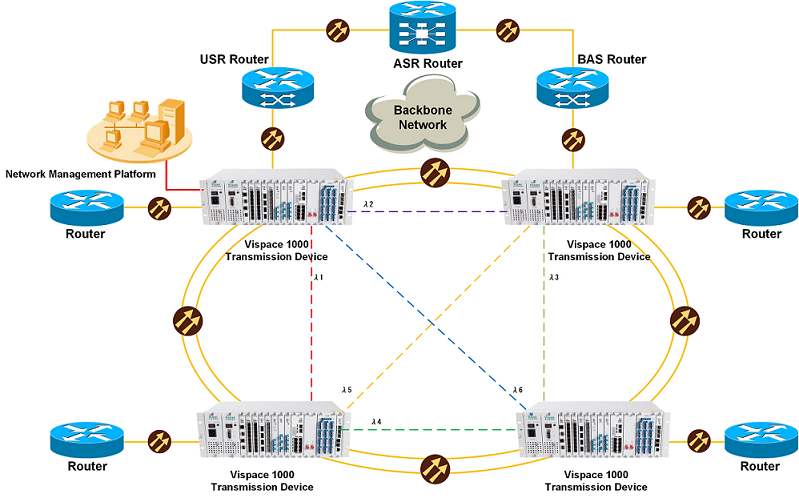
100G Integrated WDM System
Product Overview
The integrated WDM device is designed and developed by Visint for data center to interconnect fiber links. It has the advantages of transparent service, low delay, high capacity, low energy consumption, simple operation and stable and reliable equipment. Maximum supports for 1.2T service access interaction capacity. Supporting single-wave 10G/100G/200G rate, suitable for SDH, SAN, SONET, ETHERNET, OTN, DCI interconnection, etc., It provides a high-quality solution for solving transmission lines with insufficient fiber resources and high fiber line loss.
Inquiry Now
The integrated WDM device is designed and developed by Visint® for data center to interconnect fiber links. It has the advantages of transparent service, low delay, high capacity, low energy consumption, simple operation and stable and reliable equipment. Maximum supports for 1.2T service access interaction capacity. Supporting single-wave 10G/100G/200G rate, suitable for SDH, SAN, SONET, ETHERNET, OTN, DCI interconnection, etc., It provides a high-quality solution for solving transmission lines with insufficient fiber resources and high fiber line loss.
Supporting 10G up to 48 channels of service or 100G up to 12 channels of service convergence for one core fiber transmission.
Ultra-high integration design, forward and backward wind, 1+1 protection, complete physical isolation port, transparent transmission.
Supporting multiple access 8GFC/10GE/100G Base-SR4/CWDM4/LR4/PSM4/OTU4
Supporting SNMP-based unified network management platform, the network management methods include CLI, WEB, NetRiver (graphical interface).
Supporting CDR function, which can optimize output, DDM signal monitoring and no optical signal shutdown function.
Supporting software to close the port.
System Parameter | Technical Index | |
Maximum capacity | 12*100G bidirectional transmission, 48*10G bidirectional transmission. | |
Wavelength range | DWDM: C-Band (100GHZ or 50GHZ). | |
Service access types | SDH, SAN, SONET, ETHERNET, OTN | |
Transmission distance | Support transmission distance: 10KM, 40KM, 80KM, etc. (optional). | |
Network-level protection | Line side 1+1 protection. | |
Network management function | CDR function (DDM Real time monitoring), no optical signal shutdown function, business one-way or bidirectional setting, supports in-band and out-of-band network management. | |
Network management mode | CLI , NetRiver, WEB. | |
Product dimension | 482.6 (W)*44(H)*600(D)(mm). | |
Environmental requirements | Working temperature | -10℃~+70℃. |
Storage temperature | -40℃ ~ 80℃. | |
Relative humidity | 5% ~ 95% no condensation. | |
Safety and EMC | Compliance with FCC, UL, CE, TUV, CSA standard. | |
Input power supply | AC voltage range: Supports 90V~264V 50/60HZ, DC voltage range: Supports -36V~60V. | |
Power consumption | <200W. | |
Visint® products are mainly used in the backbone core layer, metro core layer, metro aggregation layer, access layer and data center interconnection, etc. To achieve multi-service, large capacity, full transparent transmission function, which can meet the needs of operators for ultra-large capacity and ultra-long distance transmission, and provides a stable platform for operators to operate in multiple services and upgrade and expand the network in the future.
Point-to-point transmission utilizes one or two core optical fiber resources to multiplex dozens of times of optical fiber channel to realize the transmission of multiple different types of services (SDH, SONET, Internet, SAN, etc.) in one or two core optical fibers.

Figure1: Point-to-Point Networking
Chain transmission uses wavelength division multiplexing (WDM) equipment and optical add-drop multiplexing (OADM) equipment to cooperate with each other. In addition, the multi-path service between each node is constructed to construct a chain network in the metro optical communication to realize the interconnection and interoperability of multiple different types of services (SDH, SONET, Internet, SAN, etc.) between each node in one or two core optical fibers.

Figure2: Chain Networking
The ring network transmission uses the upper and lower multi-path services between each node of WDM equipment to construct the ring network transmission network in metro optical communication. It realizes the interconnection and interoperability of multiple different types of services (SDH, SONET, Internet, SAN, etc.) between each node in one or two core optical fibers.

Figure3: Ring Networking